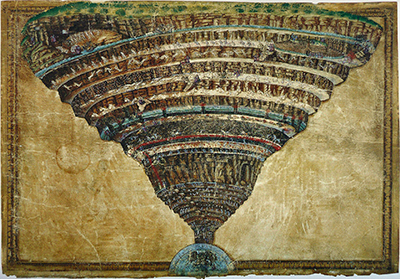Many art historians consider Sandro Botticelli's illustrative work for a manuscript of Dante's Divine Comedy to be the equal of any of his more famous fresco paintings
Botticelli's work in sketching also allowed him to practice his portraiture quickly and easily, also benefiting his larger frescos, such as Birth of Venus, Primavera and Adoration of the Magi. The flow of the female body would always inspire this Renaissance master, though his work in the Divine Comedy series was themed quite differently.
Individual artworks such as Lucifer underline how this series was dark and moody, capturing mystical creatures in biblical tales. Clear comparisons can be made with some of the artists from the Northern Renaissance, such as Hieronymus Bosch. His own take on creatures from the depths can be found in The Garden of Earthly Delights, Haywain Triptych and The Last Judgement.
The Kupferstichkabinett, in Berlin, Germany owns the largest collection of his drawings, with additional items on display at the Vatican Library and the Uffizi in Florence. The investments that they made in these purchases many decades ago now appear to have been a shrewd move, with Botticelli amongst the most respected artists from the Renaissance.
Artist Botticelli produced 92 full-page artworks for his series supporting exerts from Dante's Divine Comedy but they have since been separated, leading the situation today where multiple owners hold different parts of the series. Whilst from a very different style of art, you could almost compare this scenario to that of Monet's Water Lilies or Haystacks series, the individual paintings of which are now spread thinly across the world.
There has been the odd occasion in recent years where all of the remaining parts of the series have been reunited for a touring exhibition. Most notably in 2000-2001 a display of all of the drawings was hosted in Berlin, Rome and London. It is a similar situation to Raphael drawings which were collected together recently for an exhibition in the UK.
A significant number of paintings by the Renaissance masters are not well suited to travel, with many being part of key installations in historic buildings. The artist's drawings, therefore, offer an excellent alternative for spreading the reputation of the artist and ensuring as many people as possible are able to enjoy some of their original artwork.
The specific drawing pictured above is titled Map of Hell and resides in the Vatican Library. Lorenzo di Pierfrancesco de' Medici was the wealthy individual who commissioned Botticelli's work for the stunning final manuscript. Many of the individual artworks are iterated as Canto I, Canto II, etc. This essentially translates from Italian as Song I, Song II... The drawing and related exert of text would be joined together on each double page spread. The use of Dante's writings would also inspire Rodin's Gates of Hell.
The achievements of Botticelli within this series were not critically acclaimed at the time, it took many years before it became normal for a prestigious artist to provide his services for literature illustrations. In more modern times illustration has become a profession that has contributed several significant names to the art world, including Alphonse Mucha, Roy Lichtenstein and Andy Warhol.
Baccio Baldini would produce engravings from some of Botticelli's drawings but most art historians agree that his ability in that medium was simply not sufficient to do justice to the subtle beauty of Botticelli's original work. As with many of the finest projects in art history, Botticelli's work was never fully completed, with only some of his drawings being engraved. Despite this, critical acclaim has arrived, if belatedly, and greater focus on Renaissance drawings has occurred in recent decades.




